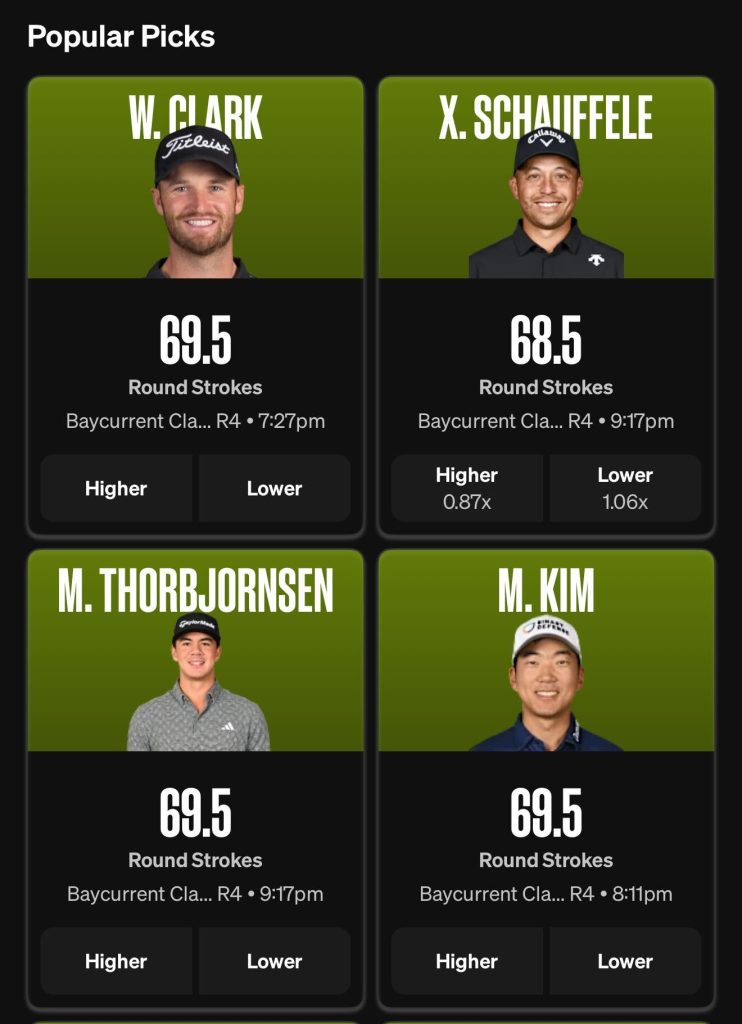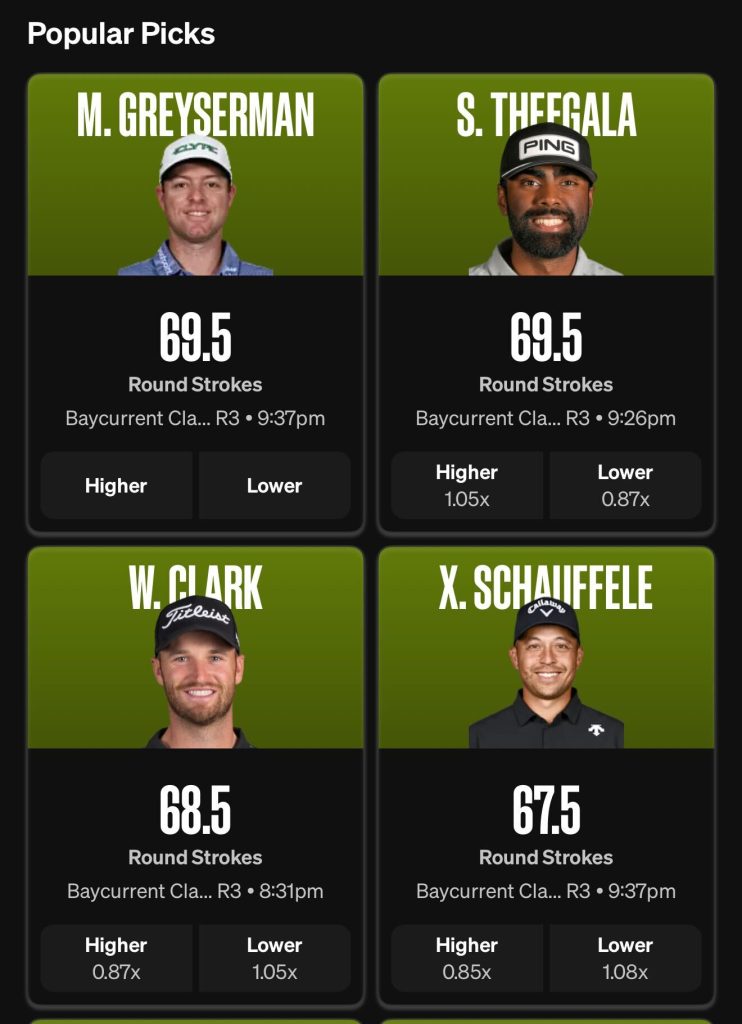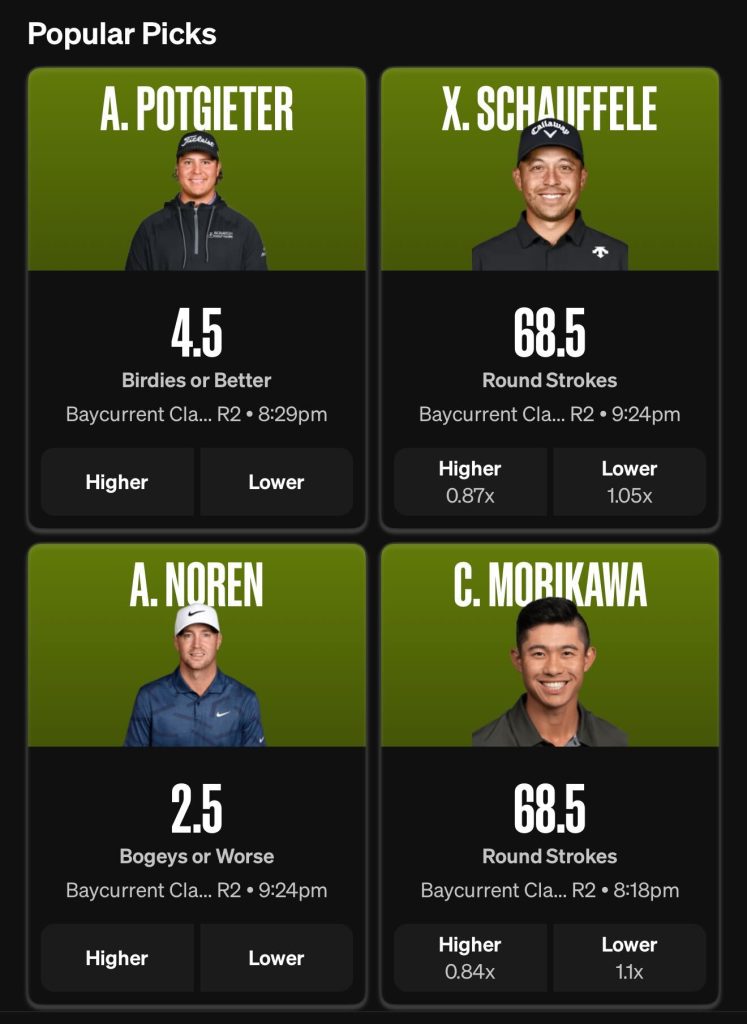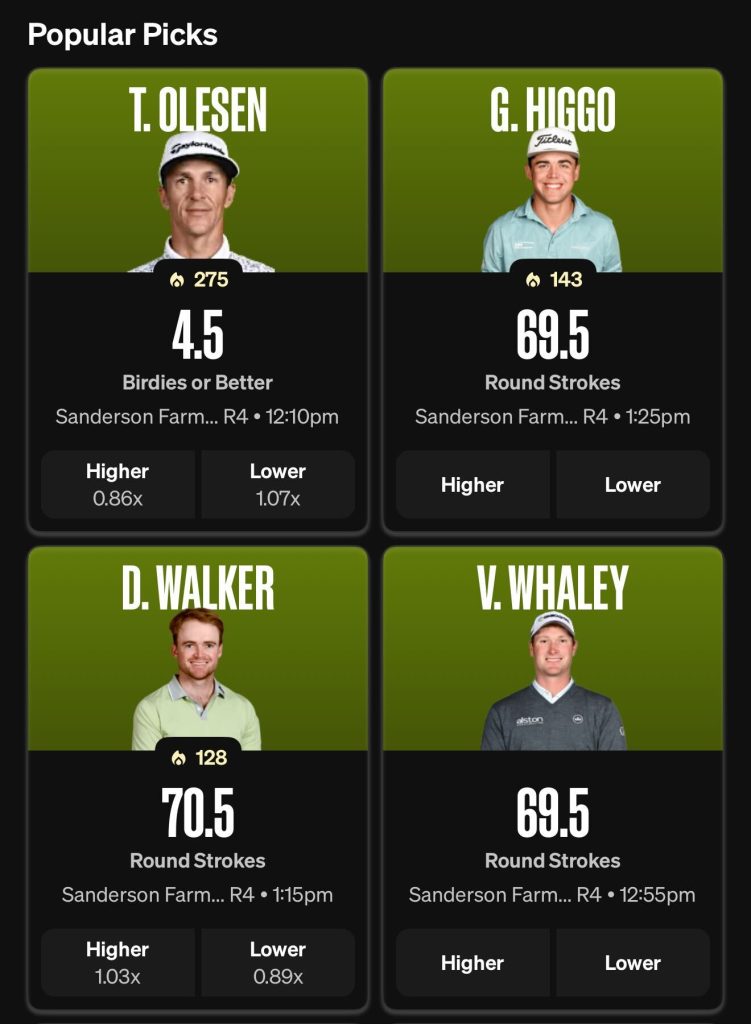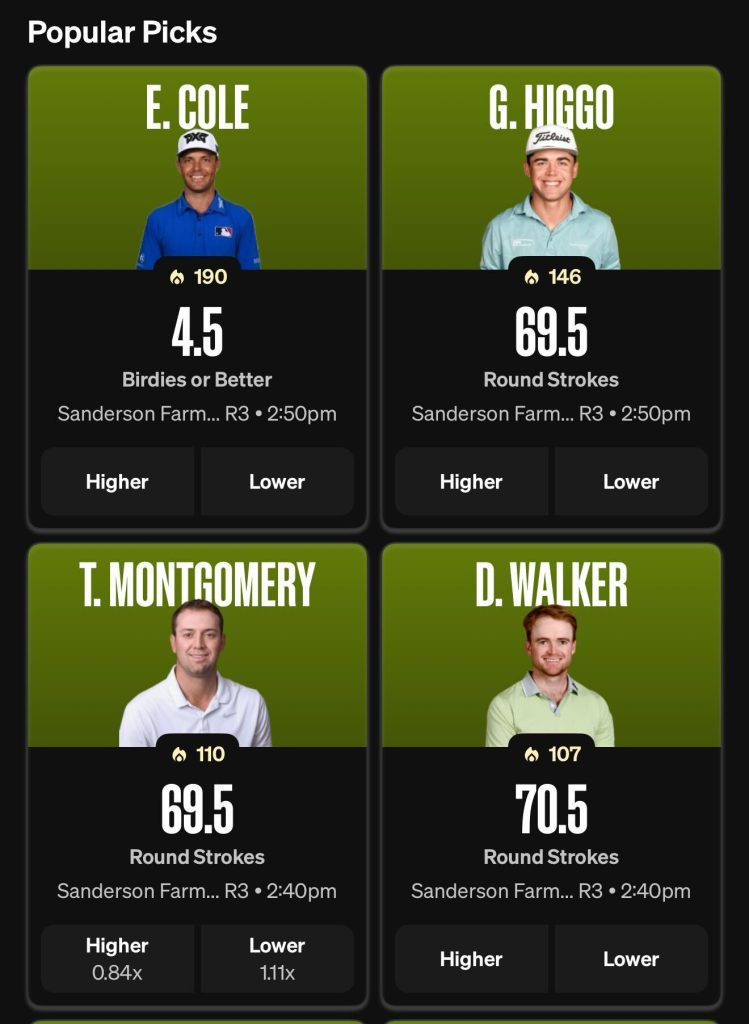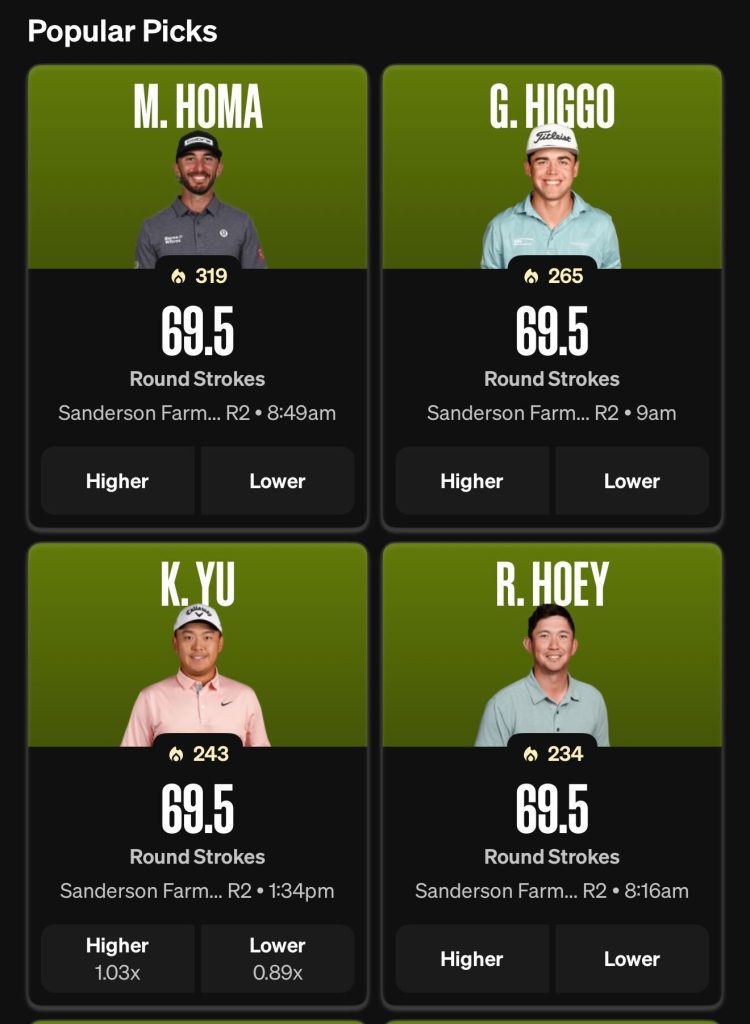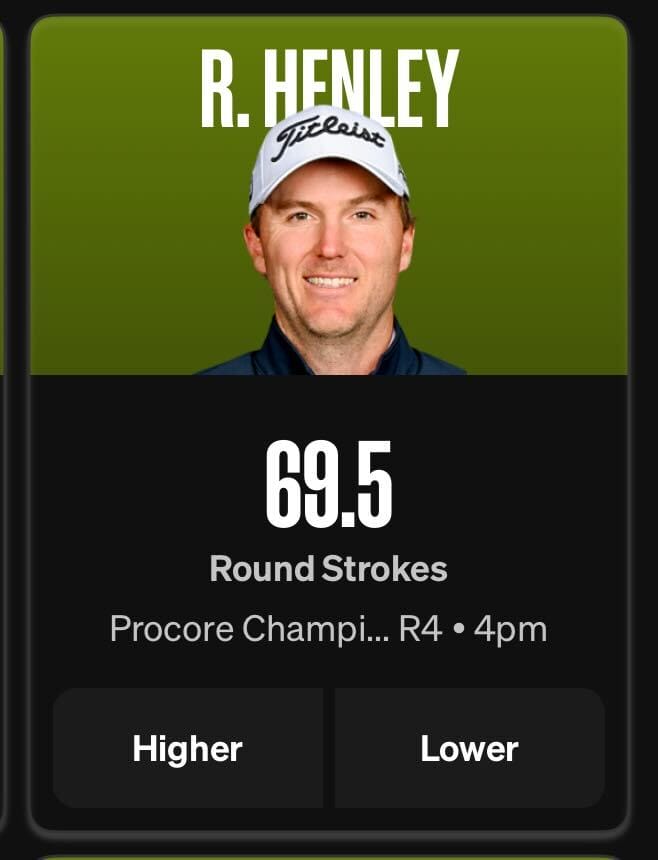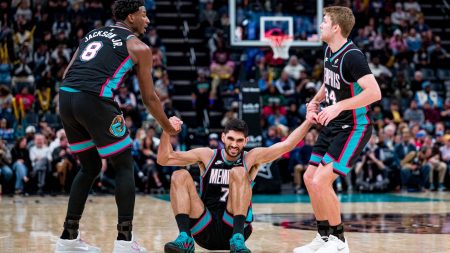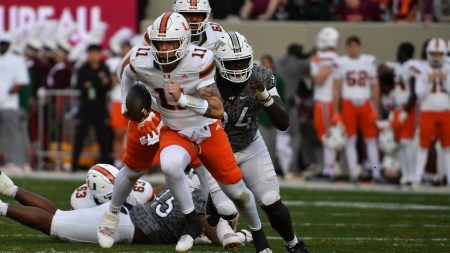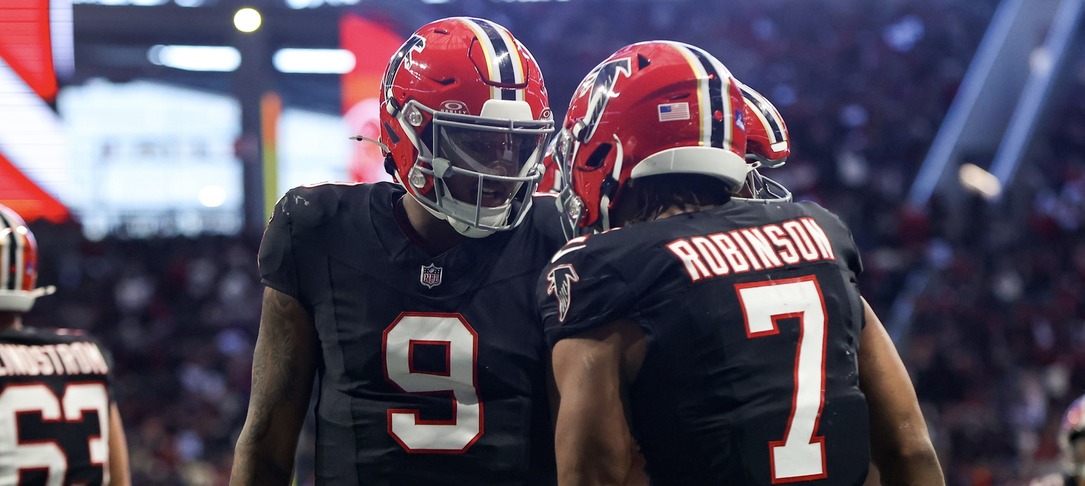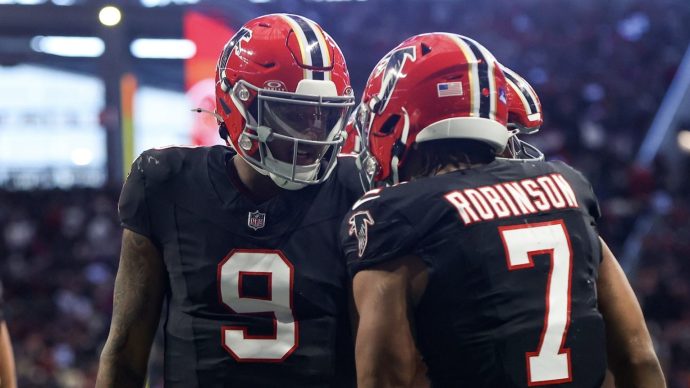In this weekly feature, we analyze some of our other favorite golf props and DFS PGA picks for Rounds 2-4.
Early in the week, we may post some of our favorite winner plays, and we’ll then check in with our favorite selections for Round 2, Round 3, and Round 4.
Top DFS Apps in All States



Golf Props Today – Round 2/3/4 Picks
Every week, we examine Rounds 2, 3, and 4 from a DFS and betting perspective.
Baycurrent Classic – Round 4
We should be in for a great finish. Xander Schauffele and Max Greyserman are tied for the lead at -12, but there is a big group at -9 and others within striking distance too.
Leaders in strokes gained: tee to green through three rounds (via Data Golf):
- Xander Schauffele (+2.81)
- Michael Thorbjornsen (+2.60)
- Sahith Theegala (+2.36)
- Alex Noren (+2.29)
- Rico Hoey (+2.27)
Notable poor putting/positive ballstriking from yesterday:
Sungjae Im (+6.56 Tee To Green, +2.48 Approach, -2.31 Putting)
Kaito Onishi (+2.97 Tee To Green, +1.80 Approach, -3.72 Putting)
A look at a few of the most popular PGA projections on the Underdog app at time of writing:
Baycurrent Classic – Round 3
Max Greyserman has raced out to a four-shot lead after two rounds at the Baycurrent Classic, with Xander Schauffele, Alex Noren and Alex Smalley all at -8.
Strokes gained: tee to green leaders after two rounds (Data Golf):
- Alex Noren (+4.07)
- Rico Hoey (+3.99)
- Sahith Theegala (+3.29)
- Alex Smalley (+3.01)
- Max Greyserman (+2.98)
Notable positive ballstriking/poor putting from yesterday:
Rico Hoey (+6.05 Tee To Green, +3.00 Approach, -5.23 Putting)
Byeong Hun An (+2.73 Tee To Green, +1.83 Approach, -2.90 Putting)
A look at a few of the most popular PGA projections on the Underdog app at time of writing:
Baycurrent Classic – Round 2
Yokohama Country Club showed some bite in the opening round. There is a trio of leaders at -4 heading into the second round at the Baycurrent Classic.
Here were the leaders in strokes gained: tee to green in Round 1 (Data Golf):
- Bud Cauley (+6.22)
- Nicolai Hojgaard (+4.79)
- Sahith Theegala (+4.13)
- Collin Morikawa (+3.95)
- Patrick Fishburn (+3.82)
Notable positive ballstriking/poor putting from yesterday:
Karl Vilips (+3.54 Tee To Green, +0.99 Approach, -4.71 Putting)
Collin Morikawa (+3.95 Tee To Green, +2.51 Approach, -2.06 Putting)
A look at a few of the most popular PGA projections on the Underdog app at time of writing:
Sanderson Farms Championship – Round 4
It’s a two-shot lead for Garrick Higgo heading into the final round on Sunday.
Here are the top five in strokes gained: tee to green thus far (Data Golf):
Steven Fisk (+3.09)
Pierceson Coody (+2.65)
Doc Redman (+2.52)
Garrick Higgo (+2.35)
Thorbjorn Olesen (+2.30)
Notable positive ballstriking/poor putting from Round 3:
J.T. Poston (+3.24 Tee To Green, +0.88 Approach, -3.82 Putting)
Trey Mullinax (+4.84 Tee To Green, +3.34 Approach, -2.42 Putting)
Popular players for Round 4 PGA on Underdog:
Sanderson Farms Championship – Round 3
Garrick Higgo holds a one-shot lead at -13 after the first two rounds.
Here are the top five in strokes gained: tee to green thus far (Data Golf):
Steven Fisk (+3.67)
Michael Thorbjornsen (+2.83)
Garrick Higgo (+2.83)
David Ford (+2.48)
Max Homa (+2.45)
Notable positive ballstriking/poor putting from Round 2:
Sam Ryder (+1.84 Tee To Green, +2.69 Approach, -4.67 Putting)
Michael Thorbjornsen (+1.52 Tee To Green, +0.47 Approach, -3.35 Putting)
Max Homa (+1.48 Tee To Green, +1.37 Approach, -3.30 Putting)
Popular players for Round 3 PGA on Underdog:
Sanderson Farms Championship – Round 2
A group of four is out in the lead at -7 after the first round at the Sanderson Farms Championship.
Here are the top five in strokes gained: tee to green thus far (Data Golf):
Kevin Yu (+4.90)
Thorbjorn Olesen (+4.80)
Michael Thorbjornsen (+4.15)
David Ford (+3.67)
Pierceson Coody (+3.67)
Notable positive ballstriking/poor putting from Round 1:
Hayden Buckley (+2.25 Tee To Green, +1.46 Approach, -2.81 Putting)
Steven Fisk (+3.20 Tee To Green, +1.31 Approach, -2.76 Putting)
Thorbjorn Olesen (+4.80 Tee To Green, +2.44 Approach, -2.36 Putting)
Popular players for Round 2 PGA on Underdog:
Our top leans for Round 2:
Thorbjorn Olesen LOWER Than 69.5 Strokes
Akshay Bhatia LOWER Than 69.5 Strokes
Good luck!
2025 Ryder Cup
Full content coming soon. We’ll be breaking down our top plays for each day of the event in this space.
In the meantime, be sure to check out our full 2025 Ryder Cup preview!
Here are some of the popular player projections on Underdog:
Procore Championship – Round 4
We should be in for a fun finish in California. Ben Griffin has the one-shot lead, but Jackson Koivun and Scottie Scheffler are right there in the mix among a host of other golfers.
Here are the leaders in strokes gained tee to green so far, via Data Golf:
Scottie Scheffler (+3.46)
Ben Griffin (+2.72)
Maverick McNealy (+2.68)
Jackson Koivun (+2.67)
Russell Henley (+2.63)
Notable poor putting/positive ballstriking from Round 3:
Brandt Snedeker (+3.94 Tee To Green, +2.51 Approach, -2.89 Putting)
Gary Woodland (+4.00 Tee To Green, +1.42 Approach, -1.95 Putting)
Michael Thorbjornsen (+3.24 Tee To Green, +1.74 Approach, -1.18 Putting)
Our top overall play for Round 4 at the Procore Championship:
Top Play: Russell Henley LOWER Than 69.5 Strokes (Underdog)
PGA Strategy – Golf Props & DFS Tips
Betting on golf is in many ways a completely different animal than normal head-to-head sports betting.
However, fundamentally it is the same baseline proposition: can we find expected value against the value offered by the marketplace?
The situation is skewed, because in golf win betting we are often dealing with tournament results and not head-to-head results, which give us tantalizing payouts and maddening near-misses on odds that are dozens to hundreds of times the multipliers of most other sports.
Something to keep in mind: just like in real tournament golf, patience and discipline and belief in your process are key, and one big event can change your entire season.
So, how do we find expected value in golf?
The Importance Of Data
Really simply, we want to find golfers who have a chance of playing better than it seems they are playing.
Buying a data subscription alone and just playing the numbers will NOT make you profitable. The advanced analytics are available to everyone, including oddsmakers.
The key is learning to understand why the data is what it is, is how we can dig into the details to find trends that are actionable.
Sites uses a strict formula to combine past results and recent results to create a projection, and it is the best overall formula anyone has ever made, but what we want to look for are golfers who can make a case that they don’t fit the exact model, and have value that isn’t being captured by projections.
So in layman’s terms, here are some really great ways you can find potential value in a golf tournament field:
Recent Form
Golfers who have a track record of playing very well, but have had some bad results lately that we expect them to bounce back from (if recent poor results are just due to poor putting alone, this is ideal, as putting is by far the most variable category in golf)
Young golfers whose true value is still increasing every week and hasn’t been captured properly by the modeling timelines that are used by Vegas and Data Golf, as well as being slow to catch the public’s eye.
Golfers who have been playing extraordinarily well lately, but historically aren’t that good, are not well captured by Vegas models.
For example, a golfer having a “breakout” year can be slow to pop in the industry models. This is an especially good situation if we can tie this performance increase to something tangible, such as a swing coach change, an offseason increase in driving distance, or another technique change or injury comeback situation.
In these cases, we want to put particular emphasis on driving and iron play, as these are less likely to be the result of random fluctuations in performance.
Course Fit
The last angle that can sometimes be used to get an edge is extreme course-fit outlier situations. The thing about mathematical models is that they can be weak in truly capturing extreme outliers.
On the PGA Tour, course fit week-to-week is much talked about and a very entertaining aspect of the game for fans and commentators, but it is generally very well accounted for by Vegas, and most tend to over-value these adjustments.
OVERALL FORM AND RATING IS ALWAYS MORE IMPORTANT THAN COURSE-FIT — a good fit for the course should always just be the icing on the cake for a good play.
One thing to look out for is the really extreme length outliers – the very longest and very shortest few courses each season, that truly limit a portion of the field from competing with their best weapons.
This happens in just a few events per year, but it does happen, and there you can find value in a true “specialist” in the field, such as guys who make their career through putting and putting alone, or an absolutely wild bomber who doesn’t gain many strokes through the rest of the bag.
Featured Image Credit: Imagn

